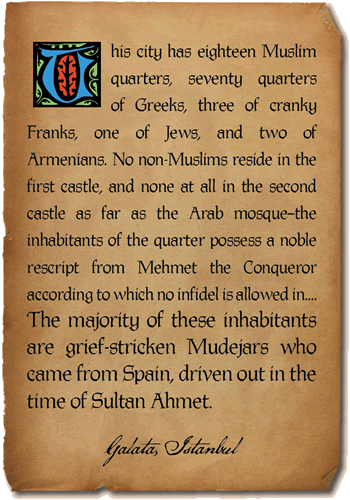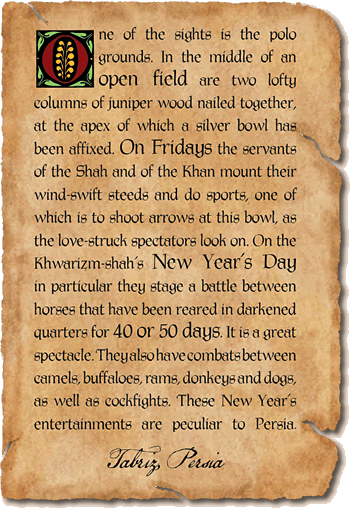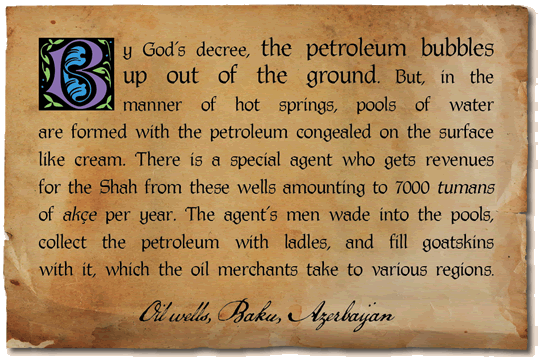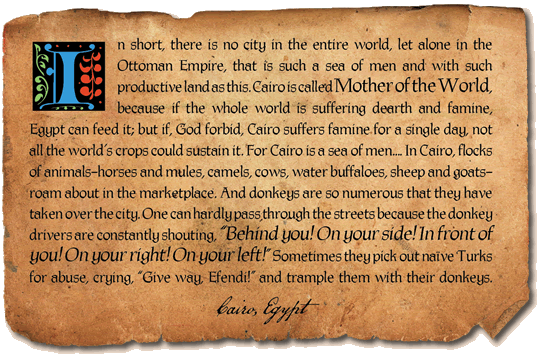 his year marks the 400th anniversary of the birth of the world’s least-known great traveler, a man who visited the ends of the earth for the sheer pleasure of doing so. For Evliya Çelebi, court favorite of the Ottoman sultan and a native son of his beloved Istanbul, the ends of the earth were the western, eastern, southern and northern boundaries of the Ottoman Empire, and at the time of his death, probably in the year 1683, it can be said that he even surpassed those limits, having visited—if he can be taken at his word, which was not always reliable—Amsterdam, Persia, Ethiopia and Russia.
his year marks the 400th anniversary of the birth of the world’s least-known great traveler, a man who visited the ends of the earth for the sheer pleasure of doing so. For Evliya Çelebi, court favorite of the Ottoman sultan and a native son of his beloved Istanbul, the ends of the earth were the western, eastern, southern and northern boundaries of the Ottoman Empire, and at the time of his death, probably in the year 1683, it can be said that he even surpassed those limits, having visited—if he can be taken at his word, which was not always reliable—Amsterdam, Persia, Ethiopia and Russia.
Evliya’s written legacy is the Seyahatname, or Book of Travels, comprising 10 volumes and thousands of pages composed in the highly recondite language of Ottoman Turkish. To date, only parts of it have been translated into English, by Robert Dankoff and Sooyong Kim, from whose book the quotations in this article are taken. As the translators note, their job was not easy, for Evliya’s language is prolix, exuberant and playful, full of allusions to the Qur’an, folk proverbs in Arabic and Turkish, and classics such as Firdawsi’s Shahnama and Sa'di’s Gulistan.
And, as things often went in the Ottoman Empire, it was due to the good offices of an unusual palace insider—in this case, Hajı Beşir Ağa, the Chief Black Eunuch—that Evliya’s manuscript was plucked from obscurity in a Cairo library decades after his death and brought to Istanbul in 1742, where it was copied and widely read.
In the words of Dankoff, professor emeritus at the University of Chicago and a lifelong student of Evliya’s work, it is “the longest and fullest travel account in Islamic literature, perhaps in world literature.” Yet it is also both less and more than this. Dankoff has compared the Seyahatname to a mine that can be dug into deeply here and there, but is rarely tunneled through from end to end. For Evliya, he wrote, “travel was not a diversion but rather an obsession. He had to see everything, and he had to record everything he saw.”
And more: The Seyahatname is also full of fancies and dreams, accounts of imagined and idealized trips that Evliya never had the chance to take—a “romanced travelogue” of “invented itineraries” based on a “nonchalant use of sources,” in the words of Ottoman historian Suraiya Faroqhi.
Thus it often owes more to the tall tales of Herodotus than to the eyewitness testimony of Marco Polo, resembling the surrealist works of novelists Jorge Luis Borges and Italo Calvino as much as it follows the firmly grounded footsteps of geographers Strabo and Ptolemy. “Pious yet unconventional,” Dankoff and Kim call Evliya the travel writer, who in the text most often calls himself bu hakir, meaning “this humble one” or “your humble servant.”
 |
Nonetheless, Ottoman architectural historian Machiel Kiel has cross-referenced Evliya’s descriptions of Balkan mosques, public baths and Sufi lodges with the actual sites that still stand today, and he found Evliya to be highly accurate. Thus, as much as it is a fairy tale about the places he did not visit, but only heard about second-hand, the Seyahatname is also a reasonably trusty gazetteer, especially to the many Albanian, Macedonian and Montenegrin towns that he did see with his own eyes, including Shkodër (Scutari), Berat, Gjirokastër, Vlorë, Durrës, Elbasan, Ohrid, Budva, Bar, and Ulcinj.
Nobel Prize-winning Turkish author Orhan Pamuk, writing in his imagined-history novel The White Castle about an Italian captive in the Ottoman court who told a tale that might or might not be true, reciting it in the presence of Evliya himself, takes direct inspiration from the Seyahatname. That even Miguel de Cervantes makes a brief appearance in the Seyahatname, in the guise of a “one-armed Spanish slave,” is no surprise. Just as Don Quixote dreamt dreams that seemed truer than life, so did Evliya.
At the age of 20, Evliya attests, his life of travel began with a dream in which he met not only the Prophet Muhammad, but also his Companions and the four first caliphs of Islam, along with a host of Islam’s lesser personalities. Overwhelmed by their presence, he became tongue-tied, and instead of asking for şefa'at (“intercession”) Evliya asked for seyahat (“travel”)—and was granted both. As he was told later in the dream, “Thou shalt travel through the whole world and be a marvel among men. Of the countries through which you will pass, of their castles, strongholds, wonderful antiquities, eatables and drinkables ... the extent of their provinces and the length of the days there, draw up a description which will be a monument worthy of thee.”
 |
Evliya began his travels in Book 1 in his very own city, which he lovingly called Islambol (“Islam-plenty”), walking its gated outer perimeter from sea wall to sea wall and counting each of his 30,000 paces. This first volume is a full inventory of the city’s mosques, neighborhoods and history, starting with its apocryphal founding by the Old Testament prophet Solomon, passing through its capture by Mehmet the Conqueror in 1453 (at which Evliya’s great-grandfather was the sultan’s flag bearer), and ending with a detailed description of the grand procession ordered by Sultan Murat iv in 1638 before setting out to conquer Baghdad.
Evliya was impressed by Hagia Sophia, but even more by the Süleymaniye mosque, built by Süleyman the Magnificent’s great architect Sinan on one of Istanbul’s high hills. “Beyond all description beautiful,” he called it. As he recounted, “The humble writer of these lines once saw ten Frank infidels, skillful in geometry and architecture, laid their finger on their mouth and each bit their finger with astonishment when they saw the minarets, but when they beheld the dome, they tossed up their hats and cried, Maryah!, Maryah!”
 |
Of Sultan Murat’s procession, a kind of pre-victory parade to celebrate an anticipated Ottoman defeat of the Safavids, Evliya wrote, “This procession of the imperial camp begins its march at dawn and continues the whole day until sunset and amounts to the number of 200,000 men all passing like a thundering sea,... during which the riot and confusion of the procession fills the town to a degree which is not to be expressed in language. Nowhere else has such a procession been seen or will be seen. Such is the crowd and population of that great capital Constantinople, which may God guard from all celestial and earthly mischief, and let her be inhabited until the end of the world. Amen!”
Evliya takes pleasure in enumerating the 1001 professional guilds and underworld groups that pass in the procession, telling how they dress and how they entertain the sultan, who watches from the Kiosk of the Procession outside the Topkapı Palace wall. He writes of mystics and furriers, pickpockets and prayer callers, horse dealers and beggars, booksellers and singers, executioners and grooms, dung collectors and gravediggers, soothsayers and corpse washers, insane-asylum keepers and pharmacists, pastry chefs and eaters of hallucinogenic nightshade, camel drivers and torch bearers, makers of stuffed vegetables and menders of broken cups, sponge divers and ship salvors, shepherds and bear handlers, lion tamers and sherbet makers.
Of the toy makers, he writes, “Some are dressed as children with bibs and hoods, some as nurses who care for them, while the bearded babies cry after playthings or amuse themselves with spinning cups or sounding little trumpets.” Of the opium makers: “They pass at the public procession preparing opium, some stretching out their tongues like men hanged, some crying Hai and Hui and frightening them out of their sleep.” And the circumcisers, who “adorn their shops with a great number of razors, pass circumcising some boys under the noise of drums.”
Evliya began life on the tenth of the month of Muharram in the year 1020 of the Islamic calendar (March 25, 1611). He was the son of Dervish Mehmet Ağa, in his time a soldier, prayer leader and court jeweler, or kuyumcubaşı. As his son, Evliya had a privileged education, and he took his pen name from his favorite teacher, the court imam Evliya Mehmet Efendi, adding the gentlemanly Ottoman honorific çelebi. He caught the attention of Sultan Murat for his beautiful Qur’anic recitation one day in Hagia Sophia, and he entered the court school to study penmanship, song and grammar.
 |
He gained the sultan’s further favor with his improvised wordplay and quick wit, which led to imperial permission to make his first short jaunts, described in Book 2, to Bursa and Ismet, then to Trabzon and through the Caucasus to the Sea of Azov in the Crimea. Returning by ship, he survived a wreck in a Black Sea storm. “We were tossed about in a whirlpool of grief,” he wrote, “the wind now before us, now behind us, not knowing in which direction we should go.... All the mariners turned pale and began to rub their hands.... Weeping and wailing arose as everyone despaired of life.” Evliya and his friends were saved only by fleeing to the lifeboat and bailing with their turbans, and for the rest of his life Evliya forswore travel on the open sea.
Back in Istanbul, a place he once had called “that envy of kings, that celestial haven,” he began to feel after only six months that the city had become a prison, and he embarked on his path of permanent travel. Throughout his life, Evliya never sought official court duties, fearing that he would be tied down. In time, he began to call himself simply a “world traveler.”
Thus, as he wrote, by his life’s end he was able to witness 22 battles, pass through the territories of 18 monarchs and hear 147 languages spoken. Among his experiences were attendance at a convention of tightrope walkers near Ankara, meeting with cat brokers in Ardabil, seeing oil wells in Baku and intriguing with the Kurdish warlord Abdal Khan of Bitlis, a town near Lake Van in eastern Anatolia, where he almost lost his life. Evliya first praised Abdal Khan as hezar-fen, master of 1000 skills—clockmaker, goldsmith, falconer, arrow maker—but finally had to flee him in the dead of winter through snow “as deep as a minaret.”
Evliya, who had once rhapsodized about the Ottoman sultan’s sumptuous private hammam in Topkapı Palace, was equally impressed with Abdal Khan’s bath and its attendants:
In the middle of the hall there was a water basin from which 300 fountains were spurting water to the ceilings. The servants, all Circassian and Georgian slaves, were dressed and adorned with jewels. In their richly decorated belts, they had stuck precious daggers and knives. As footwear they wore wooden shoes with mother-of-pearl decorations. They looked like peacocks from paradise. Respectfully they were handing shoulder covers and wooden shoes decorated with mother-of-pearl to the bathing guests.
Dankoff notes that Evliya is usually non-judgmental of non-Muslims in terms of religion—despite his frequent use of such terms as “faithless Germans,” “tricky Franks” and “shameless Mingrelians.” One foreigner once said to him, “You have traveled so much in the land of the infidels that you have fallen in love with them.” But he could also write disparagingly, as an Ottoman chauvinist, of “naked Arabs” and “bearded Persians,” his co-religionists.
In one ethnographically precise chapter, he compared Hungarians to Austrians, noting that the former were Lutherans and the latter Catholic, and described their different habits in warfare, ending with the quite bizarre observation that “Hungarians are more honorable and cleaner infidels. They do not wash their faces every morning with their urine as the Austrians do, but rather use water as Ottomans do.” But he added, as if in apology, “It is their custom, so we cannot censure it.”
Yet there is something about the Austrians, the Ottomans’ sworn enemy, that Evliya could not let drop. Of the Habsburg royal house, he wrote, “By the will of God, all the emperors of this royal house are equally repulsive to look at. And in all their churches and houses, as on their coins, the emperor is represented with his ugly face, and certainly if any artist dared to draw him more handsomely, he would be executed, for people would think he had been defaced. Those emperors are proud of their hideousness.”
Evliya reported some other grotesque customs he experienced firsthand such as, in the Circassian village of Bozodok, the burial of loved ones in hollow trees, so that honeybees would colonize the casket, proving beyond doubt that the deceased’s soul had been saved. This custom, however, required the family, when they later harvested and ate the honey, to spit out their relative’s teeth and hair, which Evliya himself says he did without complaint.
He had a sharp eye for cultural refinement among the Empire’s minorities, just as he looked down on the vulgarities of others. In Trab-zon, he appreciated the easy life, noting that “because of its pleasant climate and its panoramic beauty, the majority of the people are especially fond of amusements.... Carefree and airy, they are tender lovers and faithful friends. The women are Abkhazian, Georgian and Circassian, each one a beauty in her own right.”
Yet he disparaged Greek gypsies for their rude insults, of which he offered more than several increasingly off-color examples, and then assured his readers, “They have thousands of other such naughty expressions. For they are always quarrelling among themselves, day and night, and cursing each other with obscenities. They commit murder for the sake of a penny.”
Evliya’s curiosity for studying new languages matched that for tasting new food and drink. Always careful about what was proscribed and what was not under Islamic law, he happily nibbled giraffe meat on the Sudanese Nile, adding, “God willing, it is permitted. I have not found a discussion of it in the religious sources.” He agreed with his patron, Sultan Murat, then campaigning to close Istanbul’s taverns and coffeehouses, in his strong disapproval of intoxicants, even if at the same time he professed a suspiciously detailed knowledge of them.
“Since I was born,” he wrote, “I never tasted in my life of fermented beverages or forbidden things, neither tobacco nor coffee, nor tea, nor pomegranate wine nor date wine, nor mulberry wine nor melon wine, nor cacao-nut wine nor...”—he goes on to list another 15 varieties of wine—“nor beer nor opium nor love pills.... It is through my friends that I learned the use of these opiates and fermented liquors, and God, whom I call as my witness without hypocrisy, knows that I never tasted any of them.”
 |
He was not, however, often a solo traveler. Many of Evliya’s journeys were in the company of ambassadors and pashas, whom he served as secretary, prayer leader and divider of spoils following victory in battle. For this reason, Books 3 to 8 of the Seyahatname are often jumbled chronologically and geographically as he raced from one end of the Ottoman Empire to another to answer the next call of duty—but only when it suited him personally to hear it, for he was always looking for new destinations. To mention only a few places on Evliya’s itinerary—Crimea in the early days of the Romanov dynasty, Vienna in the heyday of the Habsburgs, Dubrovnik during its rivalry with the Venetian Republic—is proof enough of his keen scent for history in the making.
He described battles lost, too, such as the battle of St. Gotthard in 1664, and sieges won, such as the siege of Uyvar, Hungary in 1663 and the siege of Candia, Crete in 1669. He recounts ambassadorial missions to Persia and punitive raids to Kurdistan, and lists the castles taken and usurpers defeated, often in vivid language. “In the night,” as he wrote, “the white eunuchs cut their ağa to pieces, threw the body out and suspended it by the feet.”
Evliya told other clearly apocryphal tales, such as how he believed the New World had been discovered: Two priests, a Spaniard and a Portuguese, had first come to Sultan Beyazit ii in a dream, offering to show him the way across the sea. But Beyazit was busy with the subjugation of Makkah and turned them down. So instead the priests went to Spain to make the same offer to the Pope.
Evliya said he interviewed Native Americans in Rotterdam during the visit he claimed to have made there in 1663. It is unlikely that he actually did so, although his name does appear on a list of Ottoman delegates in the Habsburg archive in Vienna. The Indians, he says, “cursed those priests, saying, 'Our world used to be peaceful, but it has been filled by greedy people, men of this world [the Old World] who make war every year and shorten our lives.’” This gives the impression that Evliya may have been looking at all the riches of the New World and wondering, “What if it had been Turks and not Spaniards who set sail in 1492?”
 |
At the age of 60, after a dream in which his late father gave his permission, he set off in Book 9 on the pilgrimage to Makkah in 1671, returning with the Egyptian caravan to Cairo, where he lived until his death in 1683. Along with his visits to Alexandria, Ethiopia and Sudan (where, if he is to be believed, he met two fellow Turks, one riding a rhinoceros, the other an oryx), all recounted in Book 10, he gives the fullest account of Cairo since Taqi al-Din al-Maqrizi described the city more than 200 years earlier.
He tells us, for instance, what the inside of the Great Pyramid smelled like, what the Coptic language sounded like, how it felt to be squeezed in the market by passing donkeys “so numerous that they have taken over the city,” with their “silver harness and velvet saddlecloth,” and how incredulous Cairenes reacted to seven straight days of snowfall, comparing it to cotton and cold fire.
Evliya’s exhaustive listing of Cairo’s guilds and trades, from snake-meat apothecaries and donkey shearers to camel-liver cooks and rat hunters, is a fitting match to his account in Book 1 of similar employments in Istanbul. Evliya apparently felt sufficiently comfortable in Cairo to end his travels there, seek employment with the Ottoman governor, Ibrahim Pasha, take up residence in an apartment in the Citadel and write his book. “There is no city in the entire world,” he wrote, “let alone the Ottoman Empire, that is such a sea of men and with such a productive land as this.”
Thus, in the sense that Cairo was at the edge of a sandy desert, the blessing that Evliya received in his dream at age 20 came true: “May he be present at many wars, may he be a dervish, may he fear nothing, and may he dance in the sand and never strike his foot on a stone.”
After returning from the Upper Nile, where he was frightened by crocodiles and amused by monkeys “as big as Merzifon [a town in Anatolia] donkeys,” Evliya ends his Seyahatname in typically modest and playful fashion: “My tale has been long,” he wrote, “like the tail of a snake [yılan in Turkish], and you may think it is a tall tale [yalan], but, as God is my witness, this is the way it was.” He apologized for its “shameless detail,” yet asked paradoxically that, if readers found it incomplete, they forgive its shortcomings because of “the length of my travels.”
For a man who traveled as far, as fast and as often as did Evliya, he never once seemed to be alone or to feel loneliness. The Seyahatname is a celebration of new friendships as much as it is of new places. As Evliya said many times when he was far from his beloved Istanbul, he was perfectly happy to be a nedim (intimate fellow) to strangers, a musahib (boon companion) to other travelers and “a friend of all mankind.” And, as he wrote from his heart, “I gave thanks to God, mindful of the proverb, 'First the companion, then the road.’”
 |
Louis Werner ([email protected]) is a writer and filmmaker living in New York. He is a frequent contributor to Saudi Aramco World and also writes for El Legado Andalusí and Américas, the magazine of the Organization of American States. |





